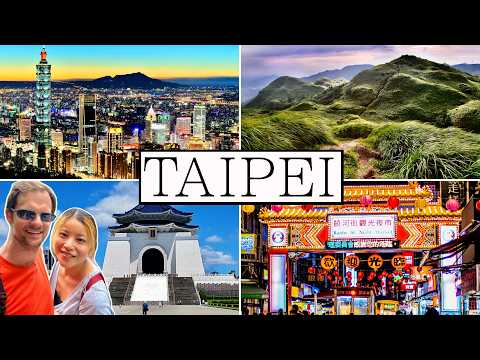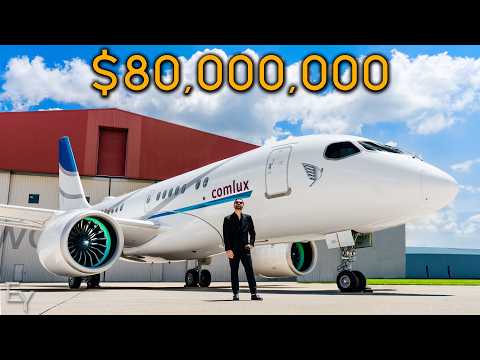NEW! 4 Days in TAIPEI, TAIWAN - Asia's Best Kept Secret? Travel Vlog & Guide

This is Taipei. A somewhat overlooked city, that I can almost guarantee, is not what you might expect. Invited by their own tourism board, we were shown Taipei through the eyes of locals and tour guides as well as our own time so can now present to you, what we found, to be one of Asias best kept secrets. Mixed with an apparent influence of Japanese style and culture, a Chinese tone with food and vibrant night markets, the island of Taiwan has very much formed its own progressive, all welcoming, identity.
So in this video, we’ll show you just the tip of Teipei with nature trails, mountainous hot springs, lookout city views, bustling shopping districts, a stack of food recommendations, a selection of stylish hotels, and what has since become, our new favourite skyscraper. If you’re new here then welcome, we make travel movies and guides from around the world, hoping you might just find your next holiday inspiration. This is Suitcase Monkey spending 4 full days in Taipei.
Our journey begins with a direct flight from London Heathrow. Despite its name, China Airlines is actually a Taiwanese company and the international airport is an hour from the city, either by taxi or single direct metro line. Our first full day began with a walk around 3 must visit areas to the west of the city centre - Ximending, the hip, sub cultural hotspot, the Datong District, the historic heart of Taipei and Zhongzheng with its grand National buildings, and remnants of the old city walls. Of the 4 remaining, this Northern Gate is by far the most popular. In addition to it being
the only gate in its original form, it’s also really close to the worlds largest Pizza Hut. Although the 5 kms of wall connecting these gates were complete in 1884, it was the 1850s where this area of Taipei really became a significant trader of tea, sugar and rice. Today, you’ll still find the clearest echos of this past in Dadaocheng, and specifically along Dihua, officially the oldest street in the city. It’s a great place to window shop, and see how both old and new can blend together so perfectly… One thing we were continuously surprised about in Taipei was their obvious love for public reading and throughout the city, we’d frequently stumble upon the quiet combination of book hunting, reading and coffee. If this is your thing, Kuo's Astral Bookshop on Dihua Street is as good place to stop by. It’s also worth noting at this point, that if you’re using this video as a suggested travel itinerary I’ve also created a free written version of all the places featured in this video and some that we just don’t have time for. Restaurants such as this one but also shops,
hotels and other notable attractions, so if you want a complete list with clickable locations, scan this QR code now or visit the link in the videos description or pinned comment below. So With our stomachs full, we next headed over to the iconic Liberty Square, an impressive open space that serves significant public gatherings and presidential ceremonies. Although not immediately obvious, these red pillared buildings are actually Taiwans National Concert Hall and National Theatre. But it’s the memorial to Chiang Kai-shek, president of Taiwan for 25 years, that takes centre stage. Every day, 10 minutes before the hour, you’ll have a chance to catch the changing of the guards, which I’d recommend if you’re able to time it right. For the late afternoon and early evening, there are 2 must stop areas I’d heavily suggest on this side of town. The first is Ximending, a buzzing, trendy, hipster area
that we enjoyed so much, we came back later in the evening, when it really comes alive. Ximending was the first pedestrian zoned area in Taipei and remains the largest to this day. Amusement arcades, shopping malls, retro clothing, and a walk way literally called Tattoo Street. It’s impossible not to find something of interest here. For us, we really loved the Red House. Now an independent boutique hub,
it started life as the city’s first public market. Built during the Japanese colonial period it remains one of the best preserved buildings from its time. The stores inside are also frequently rotated so even the locals aren’t sure what to expect. A relatively new tourist attraction, just outside, is Rainbow Road. Ximending has long been considered the centre of LGBTQ+ in Taipei but it was 2019 when Taiwan became the first country in Asia to legalise same sex marriage, hence the addition of this road. The most famous collection
of LGBTQ+ bars are all along Lane 10, just next to the Red House where everyone is welcome. Also vying for Taipeis coolest neighbourhood is Zhongshan, just 2 stops along the metro. Whilst the main road is full of big commercial brands, during the weekend, you’ll find 500 meters of independent stalls, selling clothes, jewellery, handicrafts. But it’s these easily obscured alleyways that really give the most character. For our evening meal, we visited one of the most popular restaurants in the area. Although these dumplings or Xiao Long Bao, originated in China, it was this restaurant in Taipei that made them globally famous and they take that history seriously. This team are folding each one a precise 18 times, giving the perfect
texture. After all their work, there’s also a helpful info card on how best to enjoy them, although looking at this, any British viewers, will immediately think they’ve missed a parcel. After a busy first day, we relaxed back at the hotel to rest our legs. And that’s because tomorrow we’d be heading into the nearby countryside that circles the entire city.
The Taipei Grand trail is a purpose built 92km hiking path, showcasing some of the cities most scenic landscapes… Split into 8 different sections, this relatively accessible route connects to train lines and cable cars, and over the next 2 days, we’d sample areas around Sections 3 and 7… The Chih Nan Temple is a Taoist temple built in 1882. Historically it was famous for its 1000 steps you’d have to climb in order to reach. Although the cable car has since made it more accessible to visitors, those hiking the Grand Trail can still visit as it was intended, which, despite the extra effort, makes the destination all the more rewarding… One thing to always keep a look out for during any temple visit are these moon blocks. These divination tools originated in China and allow you to ask any yes/no question, with the answer determined by how they both land. And yes, for anyone wondering, I’ve since sold, all my Bitcoin. Our third and final stop on the cable car circuit took us to its highest point of Maokong Station.
There’s a nice stretch of road here with various cafes and restaurants looking out over the scene below. Price wise, we generally found Taipei to be between reasonable and low cost. Most 2 or 3 course lunches or dinners would total around $10 to $12 US dollars per person, and that was going to popular or nice restaurants. For example, later in the evening, we visited Livingreen, once a former police station from the 60s, it’s now been repurposed into a well presented casual diner, where every dish absolutely hit the spot. Hot tea was served in this pot with an
egg timer and cold tea, in this wine glass, which somehow added to the overall flavour. But, we are getting ahead of ourselves here. We still have one last stop in the mountains, and that was Beitou… Less than an hour from our hotel, Beitou is the geothermal capital of Taiwan, and either makes for the perfect half day trip or a single nights stay in one of its cozy hot spring hotels. Whilst knowledge of the area goes back as far back as the Taiwanese indigenous peoples, using Beitou as a place to relax came to life during the Japanese occupation. With their own experience of onsens, they quickly realised Beitou’s potential healing benefits and by 1916, built this train station to make the escape from the city all the more comfortable. The original space has now been repurposed into this tiny museum that puts its own history into context really well .
Something that has to be on everyone’s Taipei bucket list, is a visit to any one of its 30 plus Night Markets. And we were able to visit 2 of its most popular; Shilin, and Raohe. At either of these, you’ll be able to sample a wide selection of small bites, usually around $1 to $2 US dollars per serving. It’s fun, noisy and busy,
but you can’t get a much better deal for delicious Taiwanese street food. Some personal food favourites include this hot dog where the bun was actually sticky rice instead of bread, this spring roll with 3 scoops of ice cream inside along with a double dose of peanut shavings, these sweet potato balls which had an almost churros feel to them, these light, crispy egg pancakes which were delicious and why not finish with some deep fried milk ice cream for good measure. Out of the 2 night markets we visited, we probably enjoyed Raohe the most. It was slightly smaller than Shilin, but had two lanes of traffic which made it a little easier to navigate. But overall, we largely got a similar vibe at each,
so if you only had one opportunity to visit, there isn’t a wrong choice with either. So with that, our time in Taipei was almost complete, but we still have one giant attraction, one that we haven’t even touched upon… No matter where we were throughout Taipei, this striking structure frequently sat prominent on the horizon. And for our last day, we’d finally get the chance to see it up close, where it legitimately became my new favourite skyscraper. The area is Xinyi. The modern, highest reaching district, we came away from here wanting another
day. With the highest density of shopping malls in the world, along with a bunch of cool cafes that are right up our street, we felt like we barely scratched the surface. We did however, have plenty of time to sink our teeth into Taipei 101 itself, a building that certainly doesn’t disappoint on arrival and somewhere I’d definitely recommend a visit. Its unique design is based on a continuously growing bamboo stem, making it the first skyscraper to have a traditional Asian aesthetic. Opened in 2004, its lift zooms you up at 1000 meters a minute. So, after just 37 seconds we reached the 89th floor and, were met with the new perspective of what it looks like to be inside a cloud… To be fair though, you may have noticed that it’s been raining a fair amount on this trip and that’s because we were caught by a Typhoon that was heading our way. So all
things considered, we were actually pretty happy with what we eventually got to see. There’s a bunch of fun photo opportunities to be had and plenty of space to walk around, but one unexpected highlight was this. What you’re looking at is a 660 ton damper ball suspended from the 92nd floor, and is the only one in the world open to the general public. If, like me, you’re wondering what it exactly does, then check out this 2015 video. On the outside, a typhoon was causing the building to sway 2 meters and this is what was happening on the inside. Ultimately, this swing counter balances any forces received by up to 40%. Although as much as I was amazed by this impressive engineering feat,
nothing quite compared to my total wonder of this persons ability to continue posing for a photo, even during a 6.3 magnitude earthquake. Now that is dedication. To go full circle, there are numerous viewing platforms to catch a sunset or even night time view of Taipei 101. Depending on how far you go, this city hike can take anywhere between 20 or 30 minutes and beyond. Just be prepared though,
there are a lot of steps, but the reward is certainly worth it. For those wanting a slightly more comfortable viewing platform, I can also recommend the last hotel we stayed at. To round off this video, I’ll be going through a quick fire travel guide with things that might help anyone thinking of visiting Taipei. I’ll cover the hotels we
stayed at, some notes on safety, and how best to get around the city with public transport. So, to let you in a bit behind the scenes, despite this videos title, we were actually in Taipei for 6 nights. But the first 2 simply just arriving and then getting over jet lag. So we actually stayed in 3 different hotels around the city for a couple of nights in each and again for everything I’m about to talk, and everything featured so far, I’ve also made a written PDF version with clickable links and further info, which should be really helpful if you’re planning a visit here. So our first stay was this really cool, apartment hotel. It came with a stylish
homely vibe, a bright open space, kitted out in furnishings from Taiwanese designers in a chilled neighbourhood. The location was excellent, 3 blocks from both the trendy Zhongshan as well as the historic Dadaocheng, and minutes from another famous night market called Ningxia. The second hotel had a relaxed social vibe to it, with lots of communal space and a bunch of cool detail, such as this welcome pack. Amongst other things, you get these jigsaw pieces that you can
write your own message on and share it to the community walls so it just felt really friendly atmosphere. The room itself was clean and quiet, the beds comfy and with a really good shower. Location wise, this one was a couple of blocks from The Ximending area, so Rainbow Road, The Red House and the entire pedestrian shopping area was 5 only minutes away, but without any of the noise. Our last stay had the impressive views of Taipei 101. This boutique hotel had so many cherries on
its cake. Our room had its own wifi router, the bed was massively comfortable, they offered a free shuttle to Taipei 101, and their sockets also included the 3 pin plug which as I’m sure we can all agree, is the worlds greatest power supply. For its location, the building was literally connected to the metro station and also just a couple of minutes from the Raohe Night Market. In terms of getting around the city, the public transport network is really efficient, clean and affordable. You can either pay as you go by getting these single use chips from the kiosks,
with most journeys being 20 or 25 TWD. These are a good option if you only plan on making a small number of journeys during your time here. Otherwise, the most convenient way around the city, is with the Easy Card which you can get by speaking with staff at the station desks. These are also super cheap with the cards themselves being 100 TWD and again 20/25 TWD per journey. You can
pre purchase these cards and collect at the airport which I’ve linked below in that PDF. Buses are equally efficient and clean to use with prices even lower at 15 TWD per journey. You can pay in cash, but no change is given so again the Easy Card would be an easier solution if you dont have the coins. Just a quick note on safety as it’s something really positive to share: We found Taipei to be one of the safest capital cities we’ve ever been to. Aside
from just a chilled vibe amongst the general population, we’d often see things like this iPhone sitting on its own in a busy shop. Or these TVs just sat there with no fuss. The people were all really friendly and warm, giving genuine service, and when we were on our own we didn’t have any language barriers so the city is accessible from that side also. We flew direct with China Airlines which is the only non stop flight from London Heathrow, and also has some same day connections to other Oceania countries beyond. We flew out in economy on an overnight flight and back in premium economy in the morning. Due
to the distance the economy seats were larger than the average seats you’d get and even as a 6 foot 3 man, I did feel the difference. For the return flight, since we weren’t sleeping for half of it, the further extra space was really noticeable and appreciated and the seats themselves almost as comfy as our living room couch. These videos take a long time to put together so please, if you’ve enjoyed joining us on this trip, please give it a like, subscribe and share with your friends who you think will also enjoy this fantastic city. Let me know if you have any questions or comments, I do read them all,
even if I can’t always respond. So as ever, until the next one, thanks for watching Suitcase Monkey.
2023-11-08 04:13


